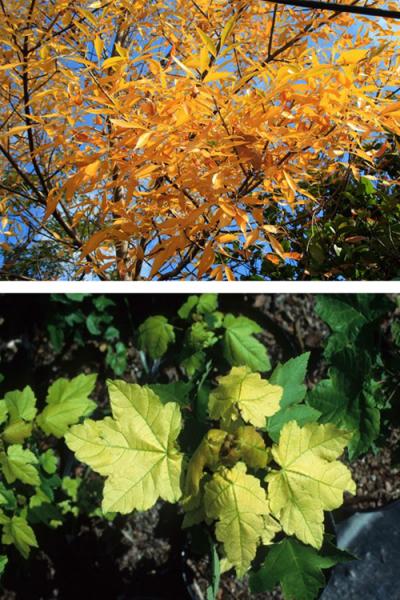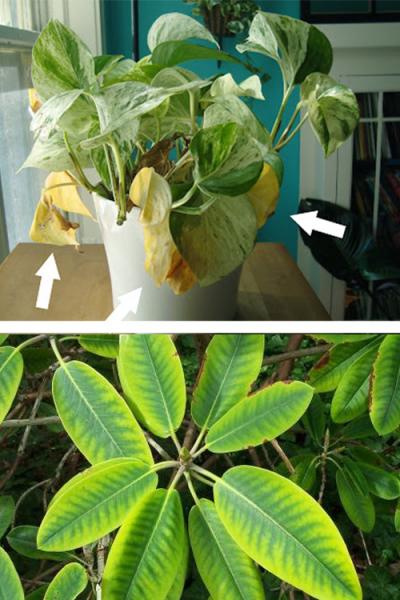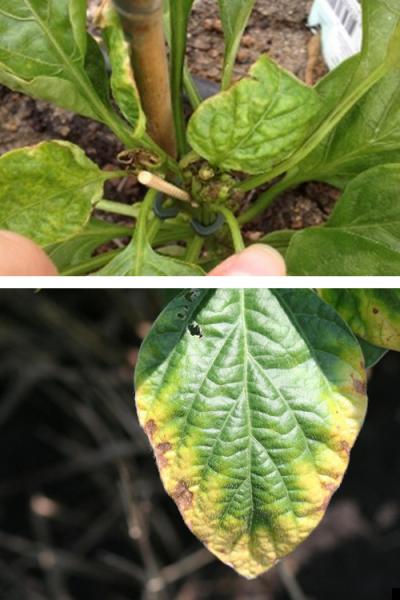What Leaves Can Tell You?
Leaves are a bit like barometers; they can tell you what is happening inside your plants. If you look regularly, you will be able to tell when they need some help, so you can come to the rescue. Foliage are a plant’s food factories. Chlorophyll captures the sun’s energy and combines water with carbon dioxide to make sugar in a process called photosynthesis. This is vital for healthy plants. If conditions disrupt this process, the leaves on a plant will show it. Here are some signs to watch for and some tips for container grown plants:

Yellow Leaves
In Autumn many plants get ready for winter; breaking down chlorophyll so that their leaves change colour, usually to yellow but sometimes orange or red. This is quite natural and should cause no concern. However, yellow leaves are also a symptom that a plant is under stress. There are several reasons why this might happen:
Underwatering:
If the growing media in the plant’s container is dry and leaves are wilting, put the pot (that has drainage holes) on a dish so that the plant can recollect any water that overflows and give it a good drink of water.
Overwatering:
If the growing media is wet, smelly and maybe covered in moss or liverworts; you probably need to water the plant less frequently

Not Enough Light: If your plant is in a low-light situation all the time, the photosynthesis rate will decrease. Try moving your plant to an area where it will receive more indirect sunlight, (or direct sunlight for sun loving plants).
Temperature: Plants are sensitive to heat and cold, and the temperature can affect the leaves. Cold drafts on a tropical plant will result in the leaves turning yellow.
Nutrients: If your plant is not getting enough nutrients, its foliage may turn yellow. If older foliage turns yellow but new shoots are green; this is commonly a sign of nitrogen deficiency. This can also be caused if you are using hard water, as the calcium in the water can also cause the leaves to turn yellow. In this case, you will see that the plant’s top leaves will be the first to go yellow. Interveinal chlorosis occurring on new growth can sometimes be a sign of iron deficiency

Tips Of Leaves Turning Brown:
Usually, the first sign of overwatering is when the tips of the leaves turn brown. It can also be a sign of exposure to heat.
Leaves Falling Off: Leaves falling off of a plant will indicate either too much or too little water. If young and old leaves are falling off and there are no buds opening, then this is a sign of too much water.
Dark Green Leaves Turned Downward: This could be a sign of overfeeding. It signals that the plant is trying to process too many nutrients. If this is happening to the leaves on your plant, reduce the amount or frequency of the solution that you are feeding it with and see if the plant improves.

Leaves Curl Upward
The opposite of leaves turning downward, this can indicate that the plant is missing a needed nutrient. If potassium is needed, older leaves will curl upward and turn yellow. If calcium is needed, younger leaves will curl upward and become stiff. A blue hue along the edge of the leaves that curl upward will indicate that the soil's copper levels are too low. In these cases, all-purpose fertilizer like a liquid seaweed feed will provide emergency nutrients for your plant but if this does not cure it, consider moving the plant.
Leaf Colour
The colour of plant leaves will tell you a lot about a plant's condition. If you see a yellow-green colour on the older leaves of the plant in the area of the tips and central vein, it could indicate a nitrogen deficiency. Leaves that are dying at the tips and have purplish or dark green hue signals that the plant needs phosphorus.
